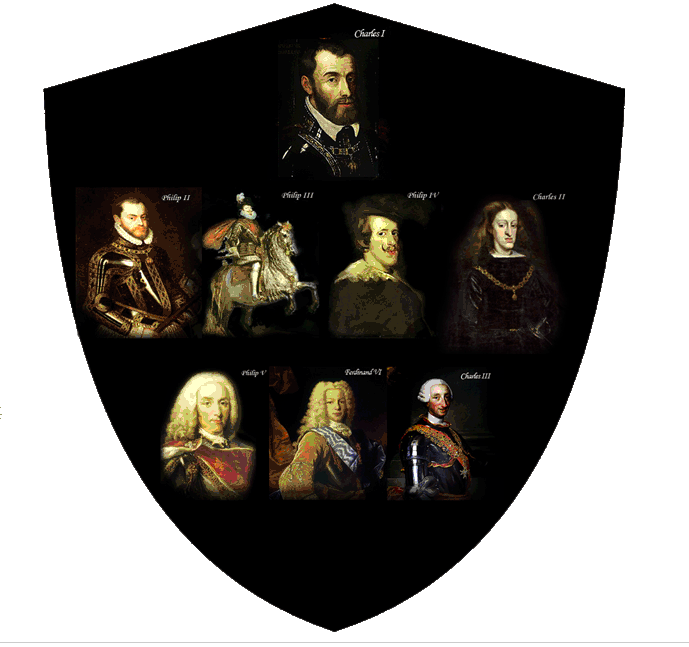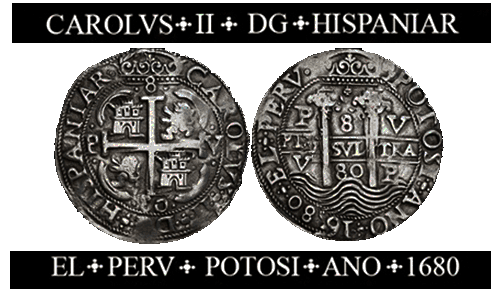
|
|
|
The student of cobs should adapt his thinking to the Spanish mode. All school children in Spain must memorize the names and reigns of Spanish monarchs, of whom the list to follow is but an abbreviated one, suitable to the time frame for cobs. All numismatic books and catalogs emanating from Spain and Spanish America classify coins by kings (as if the well-known “red book” of U.S. coins were to index its listings of quarters or nickels by U.S. presidents or periods of political hegemony). A reading knowledge of Spanish and some familiarity with Latin would be a great help too, but such accomplishments are not acquired overnight.
Here is a list of the rulers of Spain, beginning with the time of Columbus through the end of cob production in the Spanish colonies of the New World:
· Isabel I, 1474-1504.
· Ferdinand II of Aragón, 1479-1516.
The above Isabel and Ferdinand are the monarchs who unified Spain. She, Queen of Castile and León, married Ferdinand, heir to the throne of Aragón, in 1469. The joint reign dates from 1479 when Ferdinand became King of Aragón and brought that region under the joint crown. Isabel died in 1504 and Ferdinand continued to rule all their combined territories. Juana, their daughter, was married to “Philip the Handsome” of the Hapsburg line, who died in 1506; but she became Queen in name only, at the death of Ferdinand in 1516, for she was insane. Her power was presumably shared with, but in reality assumed by, her eldest son Charles, born in 1500.
· Charles I, 1516-1556.
The above Charles, first Spanish monarch to be heir of the House of Austria, named Hapsburg, was also called Charles V of the Holy Roman Empire. He did not die in 1556 but abdicated in favor of his son Philip.
· Philip II, 1556-1598.
· Philip III, 1598-1621.
· Philip IV, 1621-1665.
· Charles II, 1665-1700 (died childless).
· Philip V, 1700-1724 (first period).
First monarch of the House of Bourbon, Philip V abdicated in 1724 in favor of his son Louis.
· Louis I, 1724.
The 17-year-old Louis I became King in January and died in August of the same year 1724, whereupon his father, Philip V, was restored to the throne.
· Philip V, 1724-1746 (second period).
· Ferdinand VI, 1746-1759.
· Charles III, 1759-1788.
The above rulers’ names appear in the legend of cobs. Legends are in Latin in capital letters, with the letter V used in place of U in all elements of the legend. Here, then, are the Kings’ names in Latin, followed by their Spanish and then English equivalents, beginning with the opening of the Mexico City mint:
· CAROLVS, Carlos, Charles. (For Charles I only, the variant spellings of KAROLVS and CHAROLVS are possible.)
· PHILIPPVS (sometimes PHILIPVS or PHYLYPVS or even PHELIPVS and other variants), Felipe, Philip.
· LVDOVICVS (sometimes simply LVIS), Luis, Louis.
· FERDINANDVS (sometimes FERNANDVS), Fernando, Ferdinand.
In the case of Philip IV, it should be noted that the custom was to write his ordinal as IIII rather than IV. For Philip II the Mexican mint added the ordinal II, but the Lima and Potosí mints did not. Also, some cobs of Louis I show the Spanish word PRIMERO (“first,” sometimes abbreviated PR.), instead of the ordinal I, and Potosí cobs of Charles III use the Latin word for “third”—TERTIVS—instead of the ordinal III.
It is important to note, by the way, that most kings’ names appeared in the legends of New World cobs for a year or two (sometimes several years) after the end of their reign, owing to the slow lines of communication between Spain and her mints in the colonies. Only when a given cob bears a date, however, is the discrepancy detectable, in which case it is referred to as a “posthumous” issue.
The standard legend, running around both sides of all cobs except those minted in Guatemala (whose legends imitate the wording of the machine-made “pillar dollars” that followed cobs), said: [NAME OF THE KING], BY THE GRACE OF GOD, KING OF SPAIN AND OF THE INDIES. The last part (AND OF THE INDIES) identifies New World origin, as the cobs from the mints of mainland Spain never carried this additional title.
“King” is REX, simple enough, as is ET for “and.” “Grace of God” is DEI GRATIA, often abbreviated as DEI G., or DEI GRAT., or D.G., or just D. “Of the Indies” is the Latin genitive (possessive) plural INDIARVM, sometimes abbreviated as INDIAR. or IND. or even IN. The first letter I is sometimes rendered as a Y in both INDIARVM and HISPANIARVM, “of Spain,” often abbreviated as HISP. or HISPA. or HISPANI. and in some cases without the first letter H (as in ISPAN.), which is silent in Spanish.
Although the word “Spain” is singular, HISPANIARVM like INDIARVM is Latin genitive plural, hence literally “of the Spains.” There is a historic reason for this plural usage, rooted in feudal times before the various small kingdoms of the Iberian peninsula came to be united into one nation by Ferdinand and Isabel. Think of HISPANIARVM as meaning “of the lands of Spain” and you will be following the right thought process. The component regions of “Spain” have always had separatist tendencies. Portugal at one time was part of Spain (a joint monarchy but separate kingdoms) but ceased to be so; most people in Catalonia and its capital of Barcelona never wanted to be part of Spain; and even today the Basque provinces continue to seek independence. Throughout the peninsula the typical Spaniard’s loyalty tends to be regional first, and national second. “Las Españas,” plural, in place of “España,” singular, is not a dead term in Spanish usage even today.
Depending on the period and the mint, several more identifiers can occur in the legend. EL PERV or LIMA or POTOSI are three of them. Another is ANO, sometimes ANNO, Latin for “year,” followed by the year that the cob was issued. In this case Arabic numerals are used, and predominantly in four digits (this distinction must be made because the dates in other places on the coins may appear as only the final three or even two digits, a practice that is not so ambiguous as it may seem).
With few exceptions, the legends begin and end at 12 o’clock on both sides of the coin; but because of the considerable variation of the order in which the words of the legend appear, legends can be one of the most confusing elements on cobs. For a given stylistic period at each mint, the words of the legend did follow a specific order, despite minor variations in spelling, abbreviation, and breaking to continue the legend on the other side of the coin, and were not so haphazard as it may appear. The study of legends on cobs is quite complicated but the beginner can manage with the above information.

-Reproduction of the articles in whole or part is strictly prohibited without written permission of the author/s.
![]()
![]()
Daniel Frank Sedwick, LLC
P.O. BOX 1964 | Winter Park, Florida 32790
Phone: 407.975.3325 | Fax: 407.975.3327
We welcome your order, want lists, comments, material for sale or consignment and suggestions.
Please send email to: office@sedwickcoins.com

